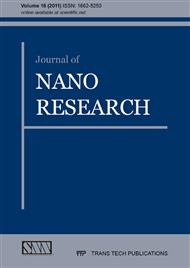[1]
M. Gerard, A. Chaubey, B.D. Malhotra, Application of conducting polymers to biosensors, Biosens. Bioelectron. 17 (2002) 345-359.
Google Scholar
[2]
C.B. Duke, L.B. Schein, Organic solids: is energy‐band theory enough?, Phys. Today 33 (1980) 42.
DOI: 10.1063/1.2913938
Google Scholar
[3]
E. Armelin, A. Meneguzzi, C.A. Ferreira, C. Aleman, Polyaniline, polypyrrole and poly(3, 4-ethylenedioxythiophene) as additives of organic coatings to prevent corrosion, Surf. Coat. Technol. 203 (2009) 3763-3769.
DOI: 10.1016/j.surfcoat.2009.06.019
Google Scholar
[4]
B.K. Annis, A.H. Narten, A.G. MacDiarmid, A.F. Richter, A covalent bond to bromine in HBr-treated polyaniline from X-ray diffraction, Synth. Met. 22 (1988) 191-199.
DOI: 10.1016/0379-6779(88)90216-0
Google Scholar
[5]
P. Vacca, M. Petrosino, R. Miscioscia, G. Nenna, C. Minarini, D. Della Sala, A. Rubino, Poly(3, 4-ethylenedioxythiophene): poly(4-styrenesulfonate) ratio: Structural, physical and hole injection properties in organic light emitting diodes, Thin Solid Films 516 (2008).
DOI: 10.1016/j.tsf.2007.12.143
Google Scholar
[6]
T. Ung, L.M. Liz-Marzan, P.J. Mulvaney, Optical Properties of Thin Films of Au@SiO2 Particles, J. Phys. Chem. B, 105, (2000) 3441-3452.
DOI: 10.1021/jp003500n
Google Scholar
[7]
I. Hussain, M. Brust, A.J. Papworth, A.I. Cooper, Preparation of Acrylate-Stabilized Gold and Silver Hydrosols and Gold−Polymer Composite Films, Langmuir 19 (2003) 4831-4835.
DOI: 10.1021/la020710d
Google Scholar
[8]
Y. Nakao, Preparation and characterisation of noble metal solid sols in poly(methyl methacrylate), J. Chem. Soc. Chem. Commun. 10 (1993) 826-828.
DOI: 10.1039/c39930000826
Google Scholar
[9]
R.V. Kumar, R. Elgamiel, Y. Diamant, A. Gedanken, Sonochemical Preparation and Characterization of Nanocrystalline Copper Oxide Embedded in Poly(vinyl alcohol) and its Effect on Crystal Growth of Copper Oxide, Langmuir 17 (2001)1406-1410.
DOI: 10.1021/la001331s
Google Scholar
[10]
R.V. Kumar, Y. Koltypin, Y.S. Cohen, D. Aurbach, O. Palchik, I. Felner, A. Gedanken, Preparation of amorphous magnetite nanoparticles embedded in polyvinyl alcohol using ultrasound radiation, J. Mater. Chem. 10 (2000)1125-1129.
DOI: 10.1039/b000440p
Google Scholar
[11]
Y. G Sun, Y.N. Xia, Resonance in Large Noble Metal Clustes, Science 298 (2002) 2176-2179.
Google Scholar
[12]
N.K. Chaki, S.G. Sudrik, H.R. Sonawane, K. Vijayamohanan, Single phase preparation of monodispersed silver nanoclusters using a unique electron transfer and cluster stabilising agent, triethylamine, Chem. Commun. 1 (2002), 76-77.
DOI: 10.1039/b107965b
Google Scholar
[13]
A.P.O. Mullane, S.E. Dale, J.V. Macpherson, P.R. Unwin, Fabrication and electrocatalytic properties of polyaniline/Pt nanoparticle composites, Chem. Commun. 14 (2004) 1606-1607.
DOI: 10.1039/b404636f
Google Scholar
[14]
S.H. Cho, S.M. Park, Electrochemistry of Conductive Polymers 39. Contacts between Conducting Polymers and Noble Metal Nanoparticles Studied by Current-Sensing Atomic Force Microscopy, J. Phys. Chem. B 110 (2006) 25656-25664.
DOI: 10.1021/jp0656781
Google Scholar
[15]
M. Ocypa, M. Ptasinska, M. Michalska, K. Maksymiuk, E.A.H. Hall, Electroless silver deposition on polypyrrole and poly(3, 4-ethylenedioxythiophene): The reaction/diffusion balance, J. Electroanal. Chem. 596 (2006)157-168.
DOI: 10.1016/j.jelechem.2006.07.032
Google Scholar
[16]
A. Lobnik, M. Cajlakovic, Sol–gel based optical sensor for continuous determination of dissolved hydrogen peroxide, Sens. Actuators B 74 (2001) 194-199.
DOI: 10.1016/s0925-4005(00)00733-4
Google Scholar
[17]
X. Liu, Y. Xu, X. Ma, G. Li, A third-generation hydrogen peroxide biosensor fabricated with hemoglobin and Triton X-100, Sens. Actuators B 106 (2005) 284-287.
DOI: 10.1016/j.snb.2004.08.010
Google Scholar
[18]
C. Fan, H. Wang, S. Sun, D. Zhu, G. Wagner, G. Li, Electron-Transfer Reactivity and Enzymatic Activity of Hemoglobin in a SP Sephadex Membrane, Anal. Chem. 73 (2001)2850-2854.
DOI: 10.1021/ac001397s
Google Scholar
[19]
J. Zhang, M. Oyama, A hydrogen peroxide sensor based on the peroxidase activity of hemoglobin immobilized on gold nanoparticles-modified ITO electrode, Electrochim. Acta 50 (2004) 85-90.
DOI: 10.1016/j.electacta.2004.07.026
Google Scholar
[20]
V.V. Shumyantseva, Y.D. Ivanov, N.F. Bistolas, W. Scheller, A.I. Archakov, U. Wollenberger, Direct Electron Transfer of Cytochrome P450 2B4 at Electrodes Modified with Nonionic Detergent and Colloidal Clay Nanoparticles, Anal. Chem. 76 (2004).
DOI: 10.1021/ac049927y
Google Scholar
[21]
Z. Dai, S. Liu, H. Ju, Direct electron transfer of cytochrome c immobilized on a NaY zeolite matrix and its application in biosensing, Electrochim. Acta 49 (2004) 2139-2144.
DOI: 10.1016/j.electacta.2003.12.040
Google Scholar
[22]
G.H. Wang, , L.M. Zhang, Using novel polysaccharide-silica hybrid material to construct an amperometric biosensor for hydrogen peroxide, J. Phys. Chem. B 110 (2006) 24864-24868.
DOI: 10.1021/jp0657078
Google Scholar
[23]
A.K.M. Kafi, G. Wu, A. Chen, A novel hydrogen peroxide biosensor based on the immobilization of horseradish peroxidase onto Au-modified titanium dioxide nanotube arrays, Biosens. Bioelectron. 24 (2008) 566-571.
DOI: 10.1016/j.bios.2008.06.004
Google Scholar
[24]
V.G. Gavalas, N.A. Chaniotakis, Phosphate biosensor based on polyelectrolyte-stabilized pyruvate oxidase, Anal. Chim. Acta 427 (2001)271-277.
DOI: 10.1016/s0003-2670(00)01204-6
Google Scholar
[25]
M.S. Lin, H.J. Leu, A Fe3O4‐Based Chemical Sensor for Cathodic Determination of Hydrogen Peroxide, Electroanalysis 17 (2005) 2068-(2073).
DOI: 10.1002/elan.200503335
Google Scholar
[26]
L. Alfonta, A. Bardea, O. Khersonsky, E. Katz, I. Willner, Chronopotentiometry and Faradaic impedance spectroscopy as signal transduction methods for the biocatalytic precipitation of an insoluble product on electrode supports: routes for enzyme sensors, immunosensors and DNA sensors, Biosens. Bioelectron. 16 (2001).
DOI: 10.1016/s0956-5663(01)00231-7
Google Scholar
[27]
M.J. Giz, S.L.A. Maranhao, R.M. Torresi, AFM morphological study of electropolymerised polyaniline films modified by surfactant and large anions, Electrochem. Commun. 2 (2000) 377-381.
DOI: 10.1016/s1388-2481(00)00041-2
Google Scholar


